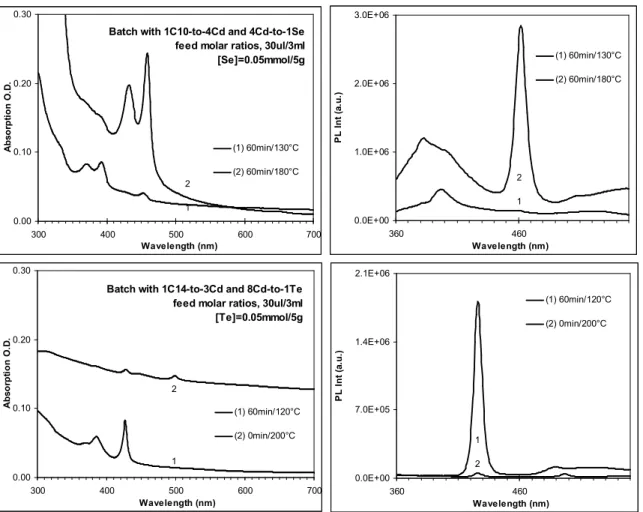Homogeneously-Alloyed CdTeSe Single-Sized Nanocrystals with Bandgap Photoluminescence
Ruibing Wang,1 Olivier Calvignanello,1 Christopher I. Ratcliffe,1 Xiaohua Wu,2 Donald M. Leek,1 Md. Badruz Zaman,1 David Kingston,3 John A. Ripmeester,1 and Kui Yu*,1 Steacie Institute for Molecular Sciences,1 Institute for Microstructural Sciences,2 and 3Institute for Chemical Process and Environmental Technology,3 National Research Council of Canada, Ottawa, Ontario K1A 0R6,
Canada
Supporting Information
1. Observation of ternary CdTeSe MSQDs, and temporal evolution of their optical properties
It has been widely accepted that, the most direct identification of MSQDs during following reaction kinetics by optical properties measurements is to observe stable (no red-shift during “growth”), persistent, and isolated peak in absorbance spectra during the reaction,1-12 whilst regular QDs growth normally features continuous and controllable absorbance red-shift over time during the reaction. Figure S1 shows, fascinatingly, the reaction gave two MSQDs ensemble, one with absorbance persistently at 428 nm and the other with lowest absorbance band stably at 520 nm. The first MSQDs ensemble, grown from 120 °C up to 160 °C, has absorbance and emission characteristics resembling binary CdTe MSQD Family 428,12 while the second MSQDs ensemble at 520 nm is an unprecedented, different from any reported binary MSQDs under the similar synthetic strageties (see Figure S1 and S2 for comparison).11,12 In addition,
113
Cd CP/MAS and HPDEC solid-state NMR spectra have confirmed that this ensemble at 428 nm is actually binary CdTe Family 428, as it only contains Cd and Te without trace of Se contribution. This is interesting, as it seems only CdTe was produced at relatively low temperature when the both precursors TOPSe and TOPTe were available. As a matter of fact, it has been demonstrated before by Nie group and Cao group independently that TOPTe is more reactive than TOPSe, and the production rate of CdTe is significant faster than CdSe.13,4 Our experimental observation exactly supports their conclusion. In addition, MSQDs ensemble CdTe 428 is not thermally stable either at temperature higher than 160 °C, from our separate investigation,12 thus were broken down and allowed the second MSQDs, a ternary ensemble, in
this reaction at 520 nm to appear. It is noteworthy that Family 524 is fairly stable, without any absorbance and emission redshifts under continuous heating at 180 °C for up to 1 hour or even higher temperature up to 220 °C.
Figure S1. Temporal evolution of the optical properties of the as-synthesized nanocrystals from one synthetic batch with octanoic acid as the capping ligand and the feed molar ratios of 1acid-to-1Cd and 8Cd-to-1Te-to-1Se; the growth periods and temperature are indicated. The as-synthesized nanocrystals were dispersed in toluene. The absorption left) and emission
(top-Temporal evoluton of emission Excitation 400 nm 0.0E+00 9.0E+05 1.8E+06 2.7E+06 410 460 510 560 610 660 710 Wavelength (nm) P L I n i ( a .u .) (1) 0min/120°C (2) 20min/120°C (3) 40min/120°C (4) 60min/120°C (5) 0min/140°C (6) 0min/160°C 4 2 1 6 5 3
Temporal evolution of absorption
0.00 0.25 0.50 0.75 300 400 500 600 700 800 Wavelength (nm) A b s o rp ti o n O .D . (1) 0min/120°C (2) 20min/120°C (3) 40min/120°C (4) 60min/120°C (5) 0min/140°C (6) 0min/160°C 6 5 4 3 2 1
Temporal evoluton of emission Excitation 400 nm 0.0E+00 9.0E+05 1.8E+06 2.7E+06 410 460 510 560 610 660 710 Wavelength (nm) P L I n i ( a .u .) (7) 0min/180°C (8) 20min/180°C (9) 40min/180°C (10) 60min/180°C 8 7 10 9 10 7
Temporal evolution of absorption
0.00 0.25 0.50 0.75 300 400 500 600 700 800 Wavelength (nm) A b s o rp ti o n O .D . (7) 0min/180°C (8) 20min/180°C (9) 40min/180°C (10) 60min/180°C 10 9 8 7
right) spectra on the top highlight the presence of CdTe MSQD Family 428 before 180 °C, and the absorption (bottom-left) and emission (bottom-right) spectra on the bottom highlight the presence of CdTeSe MSQD Family 524 at 180 °C. The examples of the synthesis of CdSe MSQD Family 395 and 463, and CdTe MSQD Family 428 from the other two previous synthetic batches for binary MSQDs are illustrated in Figure S2 for comparison.11,12
Figure S2. Absorption (top-left) and emission (top-right) spectra of CdSe MSQDs from one synthetic batch with synthetic parameters indicated, and absorption (bottom-left) and emission (bottom-right) spectra of CdTe MSQDs from another synthetic batch with synthetic parameters indicated in the figure. The growth periods and temperature are also labeled. It is clear that CdSe Family 395 grew first at 130 °C and then disappeared, while Family 463 grew at 180 °C. Also, CdTe Family 428 grew at 120 °C and then disappeared at 200 °C, while Family 500 grew.11, 12 It is noteworthy that MSQDs do not grow anymore after their formation; they stay or decompose with longer growth periods and higher reaction temperature. For the present
Batch with 1C10-to-4Cd and 4Cd-to-1Se feed molar ratios, 30ul/3ml [Se]=0.05mmol/5g 0.00 0.10 0.20 0.30 300 400 500 600 700 Wavelength (nm) A b s o rp ti o n O .D . (1) 60min/130°C (2) 60min/180°C 2 1 0.0E+00 1.0E+06 2.0E+06 3.0E+06 360 460 Wavelength (nm) P L I n t (a .u .) (1) 60min/130°C (2) 60min/180°C 2 1
Batch with 1C14-to-3Cd and 8Cd-to-1Te feed molar ratios, 30ul/3ml [Te]=0.05mmol/5g 0.00 0.10 0.20 0.30 300 400 500 600 700 Wavelength (nm) A b s o rp ti o n O .D . (1) 60min/120°C (2) 0min/200°C 2 1 0.0E+00 7.0E+05 1.4E+06 2.1E+06 360 460 Wavelength (nm) P L I n t (a .u .) (1) 60min/120°C (2) 0min/200°C 1 2
synthesis of CdTeSe MSQDs, as shown in Figure S1, CdTe Family 428 appeared first at 120 °C due to the relatively high reactivity of Te, as compared with that of Se.13,14 However, due to the thermal stability, CdTe Family 428 discomposed at ca. 180 °C, where the formation of CdTeSe MSQDs started as shown in Figure S1.
2. Solid-NMR 13C CP/MAS of CdTeSe MSQDs
The 13C CP/MAS spectra (Figure S3) with and without dipolar dephasing provide information on the dynamics of the capping ligands. The dipolar dephased spectrum (a) shows non-protonated carbons and any protonated carbons which are undergoing rapid motion show with reduced intensity. The fact that some of the CH2 resonances of the octyl chain do not appear
in the dipolar dephased spectrum (a) therefore indicates that these are static. At the same time some of the CH2 must be dynamic. The explanation is that the carboxylate group is attached
firmly to the surface and this and several of the CH2 closest to it are immobilized, whereas CH2
further along the chain have more freedom to move. The fact that the ligand is firmly attached then allows 1H-113Cd cross-polarization from the static CH2 groups to the Cd.
Figure S3. 13C CP/MAS NMR spectra of the CdTeSe 524 MSQD ensemble with (a) and without (b) dipolar dephasing, indicating that carboxylate ligands are anchored on the surface.
(b)
3. EDX Characterization
Figure S4. An electron image with the indication of the 6 different areas for our EDX analysis. A representative EDX spectrum was given in main text as Figure 4. The results are shown in Table S1.
Table S1. Atomic composition of the CdTeSe MSQD sample (with the results in atomic%) analyzed by the EDX spectra.
Spectrum In stats. Se Cd Te Spectrum 1 Yes 22.29 54.73 22.98 Spectrum 2 Yes 22.44 56.77 20.79 Spectrum 3 Yes 21.35 56.67 21.98 Spectrum 4 Yes 21.37 56.15 22.49 Spectrum 5 Yes 23.54 53.89 22.57 Spectrum 6 Yes 21.80 55.62 22.58 Mean 22.13 55.64 22.23 Std. deviation 0.83 1.14 0.78 Max. 23.54 56.77 22.98 Min. 21.35 53.89 20.79
4. Transmission Electron Microscopy (TEM)
Figure S5. One HRTEM image (left) and one electron diffraction pattern derived (right) of purified ternary F524 magic-sized nanocrystals.
5. DOSY NMR for Size Determination Fully methylated–cyclodextrin (diameter = 1.4nm) MSNs
MSN size = 1.4x(10
-9.31/10
-9.52) = 2.3 nm
toluene L o g ( d if fu si o n c o ef fi ci e n t) L o g (m 2 /s )Figure S6. DOSY NMR determines the size of MSQDs to be ca 2.3(±0.5) nm in diameter. Right y axis is log (Diffusion Coefficient) and x axis is 1H chemical shift in ppm. The diffusion coefficient of the MSQDs is 10-9.31 m2/s.
References
1. Platschek, V.; Schmidt, T.; Lerch, M.; Muller, G.; Spanhel, L.; Emmerling, A.; Fricke, J.; Foitzik, A. H.; Langer, E. Ber. Bunsen-Ges. Phys. Chem. Chem. Phys. 1998, 102, 85. 2. Peng, Z. A.; Peng, X. J. Am. Chem. Soc. 2002, 124, 3343–3353.
3. Cumberland, S. L.; Hanif, K. M.; Javier, A.; Khitrov, G. A.; Strouse, G. F.; Woessner, S. M.; Yun, C. S. Chem. Mater. 2002, 14, 1576–1584.
4. Pradhan, N.; Xu, H.; Peng, X. Nano Lett. 2006, 6, 720-724.
5. Vossmeyer, T.; Katsikas, L.; Giersig, M.; Popovic, I. G.; Diesner, K.; Chemseddine, A.; Eychmueller, A.; Weller, H. J. Phys. Chem. 1994, 98, 7665–7673.
6. Kudera, S.; Zanella, M.; Giannini, C.; Rizzo, A.; Li, Y.; Gigli, G.; Cingolani, R.; Ciccarella, G.; Spahl, W.; Parak, W. J.; Manna, L. Adv. Mater. 2007, 19, 548-552.
7. Dagtepe, P.; Chikan, V.; Jasinski, J.; Leppert, V. J. J. Phys. Chem. C 2007, 111, 14977-14983.
8. Soloviev, V. N.; Eichhofer, A.; Fenske, D.; Banin, U. J. Am. Chem. Soc. 2001, 123, 2354– 2364.
9. Bowers, M. J.; McBride, J. R.; Rosenthal, S. J. J. Am. Chem. Soc. 2005, 127, 15378– 15379.
10. Evans, C. M.; Guo, L.; Peterson, J. J.; Maccagnano-Zacher, S.; Krauss, T. D. Nano Lett. 2008, 8, 2896-2899.
11. Ouyang, J.; Zaman, Md. B.; Yan, F. J.; Johnston, D.; Li, G.; Wu, X.; Leek, D.; Ratcliffe, C. I.; Ripmeester, J. A.; Yu, K. J. Phys. Chem. C. 2008, 112, 13805-13811.
12. Wang, R.; Yu, K. Chem. Commun., submitted, 2008.
13. Bailey, R. E.; Nie, S. J. Am. Chem. Soc. 2003, 125, 7100-7106.
14. Yang, Y. A.; Wu, H.; Williams, K. R.; Cao, Y. C. Angew. Chem. Int. Ed. 2005, 44, 6712 – 6715.





